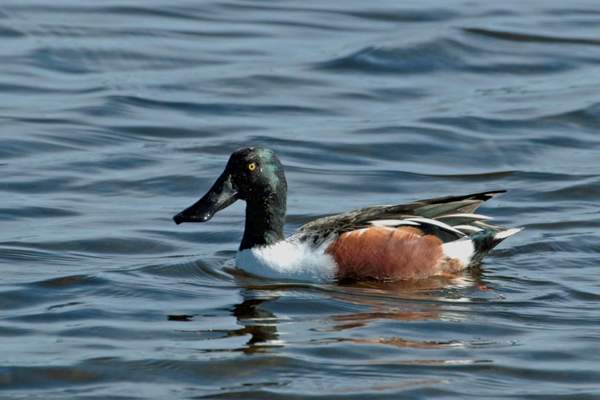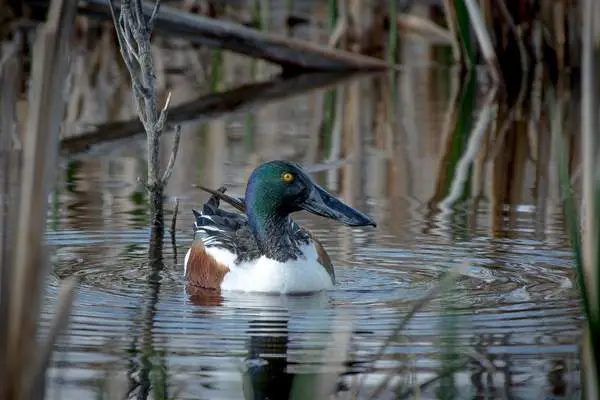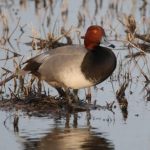Common Name: Northern Shoveler
Scientific Name: Anas clypeata| Size | Diet | Range in Hawaii | Status in Hawaii |
|---|---|---|---|
| 20 in. | insects, crustaceans, seeds and small mollusks | Main islands of Oahu and Kauai | Least Concern |
The Northern shoveler (Anas clypeata) is a medium-sized dabbling duck found in wetlands and shallow lakes throughout much of North America and Eurasia. It is known for its distinctive spoon-shaped bill, which it uses to filter small invertebrates and plants from the water as it feeds.
Northern shoveler
Appearance

The Northern shoveler is a medium-sized duck with a distinctive spoon-shaped bill that is wider at the tip than at the base. The male has a bright green head, a white breast, and a chestnut-colored breastband, while the female is a mottled brown color with a pale blue-gray bill. Both sexes have brown wings with white patches and a dark brown tail.
The Northern shoveler has a stocky body and short, rounded wings. It stands about 20 inches (51 cm) tall and weighs around 1.5 pounds (680 grams). Overall, it has a plump, rounded appearance with a thick neck and a large head.
Diet
It feeds primarily on insects, crustaceans, and small mollusks, but it also eats seeds, roots, and aquatic plants. These ducks are highly adaptable and can utilize a variety of feeding methods, including upending (dipping their heads underwater to search for food), dabbling (filtering food from the surface), and diving (swimming underwater to search for food).
Northern shovelers often feed in shallow water, where they can easily reach the bottom with their bills to extract food. They are also known to feed on agricultural crops, including wheat, corn, and rice.
Behavior
During the breeding season, male Northern shovelers engage in elaborate courtship displays, including head bobbing, wing flapping, and vocalizations. They are known to be polygamous, with males tending to mate with multiple females. Northern shovelers are migratory birds, and they typically migrate to more temperate regions in the winter.
Nesting
The female builds the nest, which is usually a simple depression in the ground lined with grass, feathers, and other materials. The female typically lays a clutch of 6-12 eggs, and she incubates them for about 23-25 days.
Both male and female Northern shovelers participate in the care and feeding of the young, which are called ducklings. The ducklings are precocial, meaning that they are able to feed themselves and move around shortly after hatching. They follow their parents to foraging areas and learn to find food on their own.
Once the ducklings are fully grown, they are able to fly and become independent. Northern shovelers are known to be social birds and often form large flocks, especially in the non-breeding season.
Habitat

The Northern shoveler (Anas clypeata) is found in a variety of wetland habitats, including marshes, ponds, lakes, and rivers.
Range
Northern shovelers may occasionally be found as winter visitors in Hawaii, especially on the main islands of Oahu and Kauai.
Conservation Status
According to the International Union for Conservation of Nature (IUCN), the Northern shoveler is considered a species of “Least Concern” on the IUCN Red List.
Interesting Facts
1. They are strong flier
The Northern shoveler is a strong flier and is known for its V-shaped formation when migrating.
2. An important food source
The Northern shoveler is an important food source for a variety of predators, including hawks, owls, and other birds of prey.
3. A popular game bird
The Northern shoveler is a popular game bird and is often hunted for sport. However, hunting regulations are in place to ensure the sustainable harvest of the species.
4. Chicks are precocial
The chicks are precocial, meaning that they are able to walk and feed themselves shortly after hatching.
5. Oldest Northern Shoveler
The oldest recorded Northern Shoveler was a male, and at least 16 years, 7 months old when he was found in California in 1969. He was originally banded in Nevada in 1952.
Frequently Asked Questions
What is special about a Northern shoveler?
One of the most unique features of the Northern shoveler is its bill, which is adapted for filter-feeding. The bill has comb-like structures on the edges that help the bird strain small aquatic invertebrates, such as insects and crustaceans, from the water.
What season do Northern shovelers migrate?
The timing of their migration depends on a variety of factors, including weather conditions, food availability, and day length. In general, northern shovelers begin their migration in the fall, with some individuals starting as early as August in some years. The majority of the population begins migrating in September and October, and the migration continues through November and December.
Are Northern shovelers rare?
Northern shovelers are not considered rare birds. They are fairly common and widespread throughout their range




